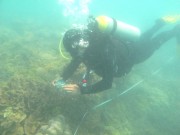Mr Angus Thompson
Author of

Introduction

Coral reefs in the coastal and inshore zones of the Great Barrier Reef (GBR) are highly valued for recreation and local tourism, but their proximity to land exposes these reefs to land runoff carrying excess amounts of fine sediments and nutrients from developed catchments. The land management initiatives under the Australian and Queensland Government's Reef Water Quality Protection Plan 2013 (Reef Plan) are key tools to improve the water quality entering the GBR and will, in the long-term, improve the environmental conditions for inshore coral reefs. Long-term monitoring of 32 inshore reefs (Figure 1) is part of the Reef Plan and is fundamental to determine the condition of inshore coral reefs and long-term trends related to Reef Plan’s actions on the catchment.
The condition of coral communities on inshore reefs of the GBR has been in a state of decline in recent years. The ninth MMP inshore coral reef survey completed in 2013 demonstrated the halting and reversal of these declines in all regions with the exception of the Fitzroy Region (Figure 2). Observed declines in coral community composition can be attributed to exposure to extreme weather events, including tropical cyclones and flooding in combination with responses to chronic environmental stress. The return to more moderate levels of runoff in 2013 and a lack of cyclone damage has allowed coral communities to begin to recover. Severe flooding in the Fitzroy Region again in 2013 has ensured the continued very poor condition of corals in that region.





